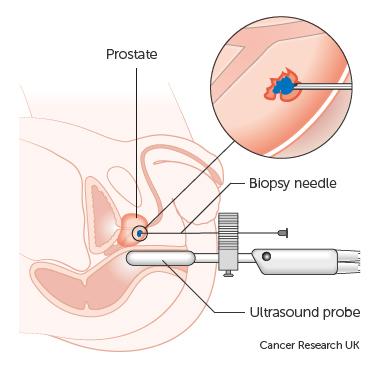Doctors may use this test to diagnose prostate cancer. You might have it if you’ve had a negative prostate biopsy but your doctor still thinks there could be a small cancer there.
This test is a needle biopsy to look for cancer cells in the prostate. Your doctor puts a needle into the prostate through the perineum, which is the skin behind the testicles. They take a number of samples, which are sent to the lab to be looked at under a microscope.
This type of procedure can sometimes find a prostate cancer that has been missed by other types of biopsy.
A transperineal biopsy can be targeted to a specific area of the prostate using MRI scans. It is then called a targeted biopsy or fusion biopsy.
There are 2 main types of transperineal biopsy:
- targeted (regular) transperineal biopsy – a relatively small number of biopsies are taken
- saturation biopsy – done under general anaesthetic and many biopsies are taken
What happens during a targeted biopsy
For a targeted biopsy your doctor uses information from your ultrasound scan and also information from an MRI scan. This helps them to accurately take biopsies from abnormal areas of the prostate gland. They may take between 30 and 50 samples.

After the biopsy
You can normally go home the same day.
You need to be in hospital for at least a few hours after a general anaesthetic, until you have fully recovered. This normally means until you have had something to eat and drink and passed urine normally. Your nurse makes sure any pain is under control before you go.
You can’t drive home if you have had a general anaesthetic because it takes some time to recover.
It is very important to drink a lot of fluids for the next 24 hours.
Side effects
Your prostate gland will bleed. And there is a risk of urine infection. Drinking plenty of fluid flushes out the blood and helps to stop you getting any infection. You will see blood in your urine, back passage and semen for a few weeks, but it won’t harm you.
Phone your doctor straight away or go to the accident and emergency department (A&E) if you have signs of infection, such as:
- shivering or shaking
- a high temperature
- a lot of difficulty passing urine
- a need to pass urine very often
- a lot of blood in your urine or poo
You need to have antibiotics straight away if you have a urine infection.
Possible risks
This test is a safe procedure but there are some possible risks.
These are:
- ongoing bleeding
- infection
- pain
- not getting enough biopsy samples
Your doctor or nurse explain these when you sign your consent form. Ask them any questions you have about the possible risks.
